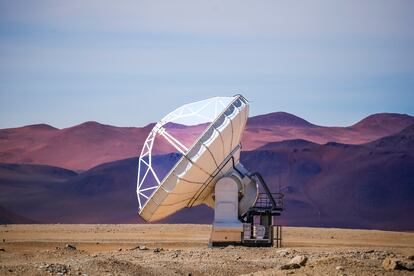EL PAÍS offers the América Futura section openly for its daily and global information contribution on sustainable development. If you want to support our journalism, subscribe here. This article was made in collaboration with Science Friday. You can read the English version here.
On April 8, Mexico and the United States synchronized for a few hours to look at the sky for one of those strange astronomical phenomena that unleash passions on Earth: a total solar eclipse. In the Urban Forest of the Mexican city of Torreón, from where NASA broadcast the event, some 50,000 people, including neighbors, astronomers and amateurs who came from different countries, saw how the Moon completely hid the solar disk. It lasted four minutes and 10 seconds in which there were cheers, applause and even tears of joy.
One of the most excited that day was Eduardo Hernández, the director of the Planetarium: “If 33 years ago, watching a partial eclipse, I fell in love with astronomy, I am sure that hundreds of vocations were sparked today,” he said after the event. The man who made it possible for the US space agency to choose his institution to show the eclipse to the world knows well the challenges of practicing this science in a country like Mexico. In his case, he assures that he had to robotize the Planetarium observatory with hardly any budget. For this reason, he warns: “Detonating a vocation is the first step, but our job is to work so that these vocations become stronger and reach somewhere.”
What was experienced in Torreón during the eclipse is perhaps the best metaphor for the state of astronomy and space exploration in Latin America. The region has some of the best places in the world for astronomical observation; and although there is a lack of investment and support from governments, there is a lot of talent for the development of this science which, according to experts from different countries consulted for this report, has enormous potential to put space research at the service of the most immediate needs of society. Land.
The Mexican astrophysicist William Lee, who is coordinator of International Relations and Affairs at the National Autonomous University of Mexico (UNAM), the largest in Latin America, defends that “very high quality” research has been carried out in the region for a long time, both in astronomy as in spatial development. However, he believes that the potential is greatly untapped in both areas. For him, the advantages range from the youth of the Latin American population, which can be trained in these areas, to the dynamism of certain economic and industrial environments or the natural characteristics of the countries.

Latin America is a privileged continent to look at the sky, as stated by Argentine astronomer Isabel Hawkins, who works at the San Francisco Exploratorium. “The countries where cutting-edge astronomical research is being done are places where there is darkness and there is height,” she lists. In the Chilean Andes, among copper mountains, ALMA, one of the largest radio telescopes in the world, has been operating for more than a decade, which was launched with financing from Europe, the United States and Japan. A little more than 400 kilometers from there, on Cerro Armazones, what is expected to be the largest telescope on the planet in 2028 is being built, a project of the European Southern Observatory (ESO). “At some point, in 2030, [en Chile] “We are going to have more than 60% of the observatories worldwide,” says Chilean astronomer Carolina Agurto, who is also co-founder of the scientific dissemination initiative. Star Three.
In Mexico, the best place for space observation is the National Astronomical Observatory of San Pedro Mártir, in Baja California. But, according to William Lee, “it has not been possible to take advantage of it 100% because, for decades, it has not received the support that astronomical research requires.” The former director of the UNAM Institute of Astronomy is convinced that his country has enough talent to develop astronomical and space projects, but it lacks incentives for innovation in the educational and industrial sectors. As an example, he cites the contribution of Mexican scientists to large-scale projects on other continents such as the Gran Telescopio Canarias, in Spain, or to the European Organization for Nuclear Research (CERN) in Switzerland. “The capacity is there, but the scale is not enough,” he laments.
The same thing happens with space exploration, which is far behind the United States or Europe. “Latin American space agencies have been slower because they require a technological base, a person who is not only an engineer, has to be a spaceman, and also have some training in an agency that has years of experience like NASA or ESA — the European one—and that is very difficult from Latin America,” says Carolina Agurto.

In Latin America and the Caribbean, less than a dozen countries have launched space agencies, including Brazil, Bolivia and Mexico. In addition, at least 15 have launched satellites into space. Recently, initiatives have emerged aimed at joining forces and sharing scientific and technological advances, such as Ibero-American Network of Aerospace Agencies, or the Latin American and Caribbean Space Agency (ALCE), promoted by Mexico and Argentina. But spending on investment and scientific development in the region is far from optimal: just over 0.60% of its Gross Domestic Product (GDP) on average in Latin America, compared to 3.46% in the United States, according to data from World Bank.
For the moment, the Latin American space race is measured in small victories: from the achievements of Latin astronauts and engineers like Colombian Diana Trujillo, who is flight director at NASA’s Johnson Space Center, to specific projects that mark milestones, such as the Mexican Colmena, run by UNAM and the Mexican Space Agency, to send microrobots to the Moon. Although this mission was not successfully completed last January due to a breakdown in the Astrobotic aircraft, the private company that transported them, the head of the laboratory that created them, the Argentine Gustavo Medina, celebrated it as a success: “ You have shown that Mexico is much more than a maquiladora. Mexico can create and can be innovative. “Those little robots are really machines made to function in space,” he encouraged his team that day, which is already working on the second phase of the project, Colmena 2.

What the experts consulted for this report are clear about is that, when it comes to space research, Latin America and the Caribbean look to the sky to solve Earth’s problems, especially in the face of the climate crisis. In Chile, for example, the armed forces have put the satellite to work FASat Charlie for the prevention of fires and nature-related disasters; Mexico has a project in collaboration with NASA to launch the Aztech Sat nanosatellite constellation for monitoring marine fauna from space and how climate change affects them; and in Brazil, satellite lasers are already used to find out how much carbon the Amazon stores.
“Commercial space research has much more to do with things that look down rather than up, to monitor biodiversity, changes in soil and vegetation, territorial developments, oceanic and atmospheric circulations…” lists William Lee, from UNAM. “Whoever has the data has more control and, if we are not there, it is a strategic loss.”

Isabel Hawkins, who fell in love with the stars when she was a girl in the Argentine countryside, worries that space will become just another territory to exploit. For this reason, she proposes that the region be a pioneer in thinking about more sustainable use. “Right now, space is not considered an environment and is completely available to be abused,” she warns. “We, Latin Americans, who are the curators of the lung of the Earth that is the Amazon, can exercise our leadership and think about a sustainable use of space. “That is an opportunity.”
#sky #solve #Earths #problems
